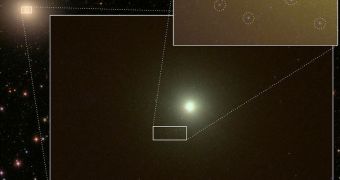A recent investigation conducted using the Hubble Space Telescope has revealed an interesting phenomenon going on inside the cores of galaxies that everyone thought were inactive. New images indicate that stellar formation is taking place at those locations still.
Messier 105 was one of the elliptical galaxies that was analyzed for this research. When using one of Hubble's most advanced instruments on the central regions of the structures, experts noticed not only new, blue stars, but also new clusters.
Until now, it was widely believed that globular clusters and elliptical galaxies had a lot in common, such as for example the fact that the stars they contained were consistent as far as age and evolution patterns go. The new paper proves this is false.
The investigation, which was conducted by a team of astronomers at the University of Michigan, was led by research fellow Alyson Ford and astronomy professor Joel Bregman. The two will present their findings today, May 31, at a meeting of the Canadian Astronomical Society in London, Ontario.
During the research, the team pointed Hubble's Wide Field Camera 3 (WFC3) towards four galaxies located some 40 million light-years away. Individual young stars and star clusters were discovered in each and every single one of them, Universe Today reports.
“Scientists thought these were dead galaxies that had finished making stars a long time ago. But we’ve shown that they are still alive and are forming stars at a fairly low level,” Ford explained.
“Astronomers previously studied star formation by looking at all of the light from an elliptical galaxy at once, because we usually can’t see individual stars,” the team member went on to say.
“Our trick is to make sensitive ultraviolet images with the Hubble Space Telescope, which allows us to see individual stars. We were confused by some of the colors of objects in our images until we realized that they must be star clusters, so most of the star formation happens in associations,” Ford said.
The new findings are interesting because ellipticals were until now considered to be boring structures, as far as stellar nurseries and the production of new stars goes. They can most often be found at the cores of galaxy clusters or superclusters.
“We’re at the beginning of a new line of research, which is very exciting, but at times confusing. We hope to follow up this discovery with new observations that will really give us insight into the process of star formation in these ‘dead’ galaxies,” Bregman concludes.
The new data could be used to gain a deeper insight into the nature of galactic evolution. In turn, this may help astronomers understand what happened during the earliest moments of the Universe.

 14 DAY TRIAL //
14 DAY TRIAL //